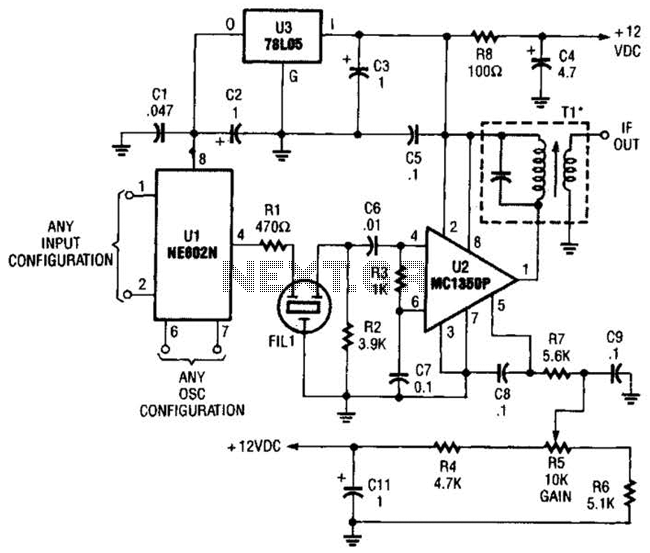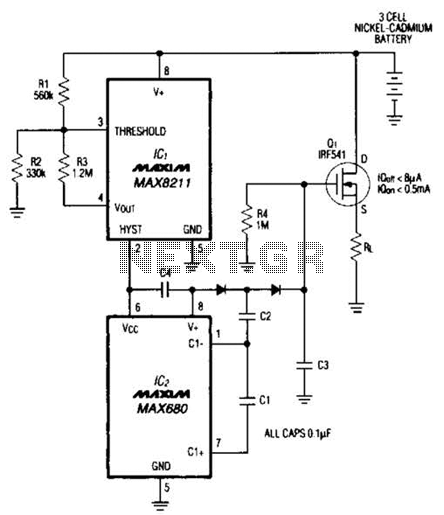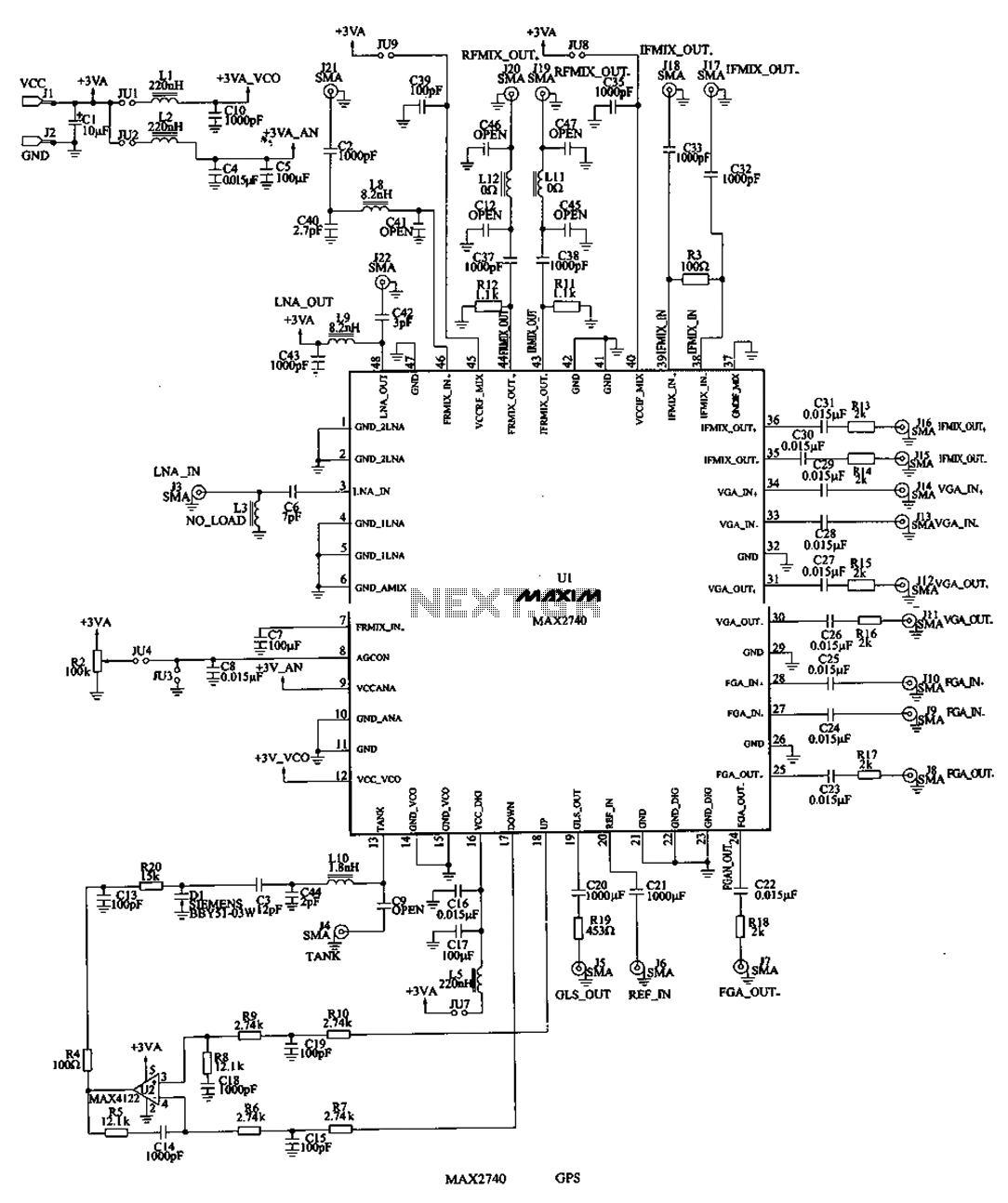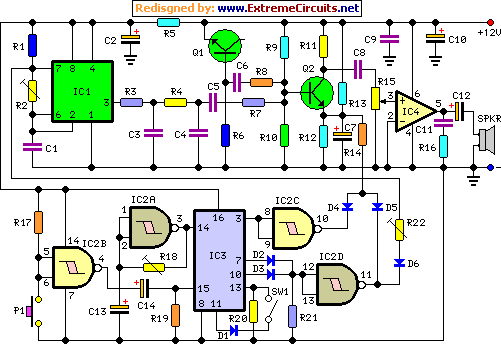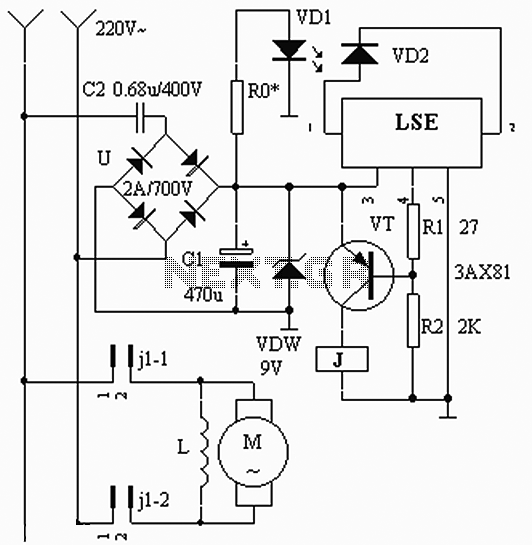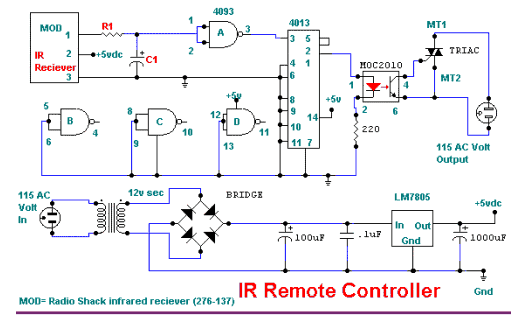
remote control circuit
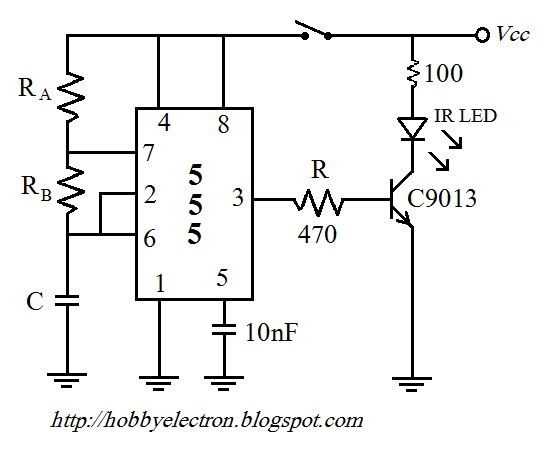
The remote control circuit comprises two main components: a transmitter and a receiver. The transmitter circuit is controlled by an NE555 integrated circuit (IC), while the receiver operates based on the frequency of the signal emitted by the transmitter. It is essential for the transmission frequency of the signal to match the decoder frequency of the receiver circuit. The frequency generated by the NE555 should align with the receiving frequency of the LM567 IC. Resistor R1 is a variable component in the receiver, allowing for adjustment to optimize signal detection. The system functions effectively once properly configured. The initial step involves optimizing the circuit, where the transmitter is continuously powered on, and R1 is adjusted to enable the receiver to detect the signal from the transmitter. The receiver circuit is governed by the LM567 IC. The schematic diagram indicates that each channel is designed to operate at a distinct frequency. Given the bandwidth of the LM567's frequency detection capability, it is recommended that there be a significant frequency difference, such as 5 kHz, between the channels.
The remote control circuit is a fundamental example of wireless communication, utilizing a transmitter and receiver setup to convey signals. The NE555 timer IC serves as a versatile component in the transmitter circuit, generating a pulse-width modulated (PWM) signal at a specific frequency. This frequency is determined by the values of external resistors and capacitors connected to the NE555, allowing for customization based on the application requirements.
In the receiver section, the LM567 is a phase-locked loop (PLL) that detects the frequency of incoming signals. The design of the receiver includes a variable resistor (R1), which enables fine-tuning of the circuit to enhance the sensitivity and accuracy of the signal detection. When the transmitter is activated, it continuously emits a signal at the predetermined frequency. The receiver, upon receiving this signal, will output a corresponding voltage that can be further processed or used to control other devices.
The schematic diagram illustrates the interconnection between the NE555 and LM567, along with the necessary passive components such as resistors and capacitors. Each channel in the receiver is designed to respond to different frequencies, ensuring that multiple remote control units can operate without interference. The recommended frequency separation of 5 kHz between channels aids in minimizing crosstalk and enhancing the reliability of communication.
Overall, this remote control circuit exemplifies the principles of frequency modulation and detection, showcasing the practical application of integrated circuits in electronic design. Proper calibration and adjustment of the components are crucial for achieving optimal performance and ensuring that the system operates effectively within its intended range.Remote control circuit consists of two parts, one is the transmitter and the other is the receiver. A simple schematic diagram of the remote control. IC transmitter transmitter circuit is controlled by NE555. Receiver circuit works by the frequency of the signal, which is emitted by the transmitter circuit. Transmission frequency of the signal mus t be equal to the decoder frequency receiver circuit. The frequency generated NE 555 is the same as the receive frequency of the IC LM 567. Resistor R1 is a variable receiver to facilitate the adjustment process. The system works well when the circuit is ready. The first step is the optimization through the transmitter is turned on continuously, while the receiver R1 to set the value of being able to detect the signal from the transmitter. The second part is the receiver is controlled by LM 567. The following is a schematic drawing receptor. In the image at the top of each channel is designed with a different frequency. Given the bandwidth of the frequency detection signal LM 567, between the frequencies on which they owe a big enough difference, let`s try with a difference of 5 KHz.
🔗 External reference
The remote control circuit is a fundamental example of wireless communication, utilizing a transmitter and receiver setup to convey signals. The NE555 timer IC serves as a versatile component in the transmitter circuit, generating a pulse-width modulated (PWM) signal at a specific frequency. This frequency is determined by the values of external resistors and capacitors connected to the NE555, allowing for customization based on the application requirements.
In the receiver section, the LM567 is a phase-locked loop (PLL) that detects the frequency of incoming signals. The design of the receiver includes a variable resistor (R1), which enables fine-tuning of the circuit to enhance the sensitivity and accuracy of the signal detection. When the transmitter is activated, it continuously emits a signal at the predetermined frequency. The receiver, upon receiving this signal, will output a corresponding voltage that can be further processed or used to control other devices.
The schematic diagram illustrates the interconnection between the NE555 and LM567, along with the necessary passive components such as resistors and capacitors. Each channel in the receiver is designed to respond to different frequencies, ensuring that multiple remote control units can operate without interference. The recommended frequency separation of 5 kHz between channels aids in minimizing crosstalk and enhancing the reliability of communication.
Overall, this remote control circuit exemplifies the principles of frequency modulation and detection, showcasing the practical application of integrated circuits in electronic design. Proper calibration and adjustment of the components are crucial for achieving optimal performance and ensuring that the system operates effectively within its intended range.Remote control circuit consists of two parts, one is the transmitter and the other is the receiver. A simple schematic diagram of the remote control. IC transmitter transmitter circuit is controlled by NE555. Receiver circuit works by the frequency of the signal, which is emitted by the transmitter circuit. Transmission frequency of the signal mus t be equal to the decoder frequency receiver circuit. The frequency generated NE 555 is the same as the receive frequency of the IC LM 567. Resistor R1 is a variable receiver to facilitate the adjustment process. The system works well when the circuit is ready. The first step is the optimization through the transmitter is turned on continuously, while the receiver R1 to set the value of being able to detect the signal from the transmitter. The second part is the receiver is controlled by LM 567. The following is a schematic drawing receptor. In the image at the top of each channel is designed with a different frequency. Given the bandwidth of the frequency detection signal LM 567, between the frequencies on which they owe a big enough difference, let`s try with a difference of 5 KHz.
🔗 External reference
Warning: include(partials/cookie-banner.php): Failed to open stream: Permission denied in /var/www/html/nextgr/view-circuit.php on line 713
Warning: include(): Failed opening 'partials/cookie-banner.php' for inclusion (include_path='.:/usr/share/php') in /var/www/html/nextgr/view-circuit.php on line 713
